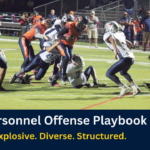Teaching Quarterbacks to Read Defensive Coverages

There are two things that a Quarterback needs to avoid when he is throwing a pass. The first is throwing it to a player on the other team and the second is a sack. The challenge for a Quarterback is to determine where the defenders will be quickly enough to get the ball out before the defense can sack him.
Teaching Quarterbacks to Read Defensive Coverages
This is where a Quarterback’s ability to read the coverage can be a huge asset. If he knows what coverage the defense will be in, he has the ability to move quicker through his progression because he knows before the snap happens who will be covered. This allows him to focus on the receiver who will be open and get him the ball quickly.
Reading coverages is not as difficult as the TV analysts make it appear. There are really only a few categories of coverage and when the Quarterback understands these different coverages, and where they are weak, he can easily find the open receiver. I have always taught Quarterbacks that there are three basic coverages and everything else is a variation of them.
The major determiner when reading coverages is how the defense is going to defend the deep middle of the field. By seeing how the defense will cover the deep middle of the field, you can figure out how they will defend the rest of the field. There are essentially three different coverages in football: Middle of Field Open (MOFO), Middle of Field Closed (MOFC) and Man. When a Quarterback understands these coverages, and more importantly the strengths and weaknesses of these coverages, he is in a position to take advantage of them.
MOFO coverage means that there is no deep defender who is responsible for the middle of the field. This is the result of the defense putting two Safeties back. Once the QB has determined that the coverage is MOFO he should move on to looking at the Cornerbacks and seeing their alignment to determine who is responsible for defending the flats. If they are close to the line of scrimmage it is safe to assume they are responsible for the flats, while if they are deeper the outside linebacker is probably responsible for the flats. In these coverages the best place to attack is down the sidelines using some sort of vertical stretch. In these passing concepts one receiver will be running a deep route along the sideline and one will be running a route to the flats. The effect is that the Cornerback is put into a bind where he must either defend the deep threat or come up to the shallow route. The routes that are popular against a MOFO with the Corners up are Go-Out and Smash.
(See Also) Go-Out Passing Concept
(See Also) The Smash Passing Concept
MOFC coverages are normally designed to stop the run. Instead of having two Safeties back to defend the deep pass, the defense only moves one back which allows them to use another defender to stop the run. Once a Quarterback has seen that he is going against a MOFC coverage he needs to check the Cornerbacks to determine if they are in a man, zone or some sort of combination. When the Cornerbacks are playing off the line of scrimmage and have their eyes inside the Quarterback can assume it is a zone coverage. When he sees this he knows that one of the linebackers or rolled down Safeties is responsible for covering the flats. In these situations it’s best to use a horizontal stretch to force that defender to make a decision. The most popular routes to achieve this horizontal stretch are the Curl-Flat and Slant-Arrow Concepts. The other area where MOFC zone coverages are weak is downfield up the seams. This is where teams can rely on the Four Vertical Concept and the different reads off of it to exploit the weak areas of the defense.
(See Also) Four Verticals Passing Concept
The final type of coverage is Man Coverage. The best way to determine if the defense is in a man coverage is by looking at the Cornerbacks. If the Cornerbacks are looking directly at the receiver it’s safe to say they are in a man coverage and the Quarterback will look to his man beating concepts.
The best man beating concepts are either based around a rub route or a double move. Most defenses go to man coverage when they are bringing some sort of blitz so it’s critical that the offense has the ability to get the ball out of the Quarterback’s hands quickly. This is where rub routes are particularly effective. In these routes the receivers will run some sort of crossing concept which makes coverage hard for defense.
If the Quarterback is confident that he will have time he can resort to double moves. These are routes where the receiver will fake one way before breaking the opposite way. These are very difficult to cover because when they are run effectively they force the coverage player to stop his momentum and accelerate in the opposite direction.
When having Quarterbacks look at coverages the most important part is to give them a framework and process to understand the defense. The MOFO/MOFC framework is especially effective for younger Quarterbacks because it gives them a simple either/or decision. This lets them quickly move through their decision making process and prepare for what they will see on the next play.











